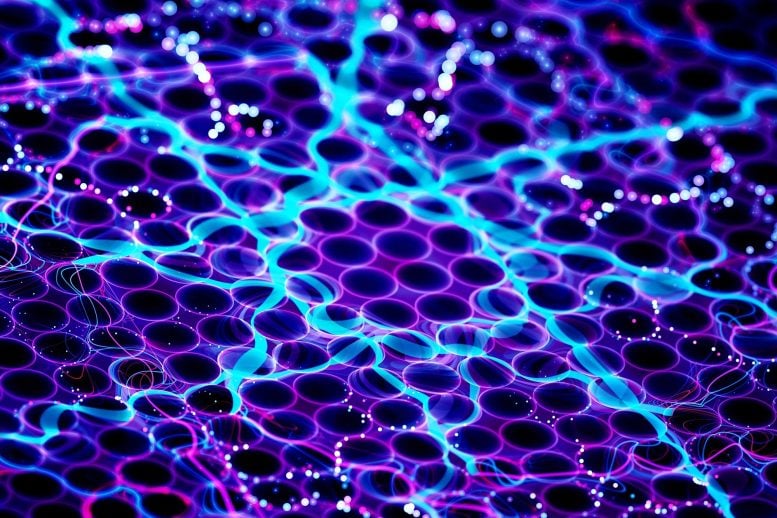Ad
 Researchers at TU Wien have developed a safer, non-toxic electrochemical method to produce MXenes, remarkable 2D materials with applications in energy storage, sensors, and solid lubrication. This breakthrough eliminates the need for hazardous hydrofluoric acid, potentially enabling industrial-scale production.
Researchers at TU Wien have developed a safer, non-toxic electrochemical method to produce MXenes, remarkable 2D materials with applications in energy storage, sensors, and solid lubrication. This breakthrough eliminates the need for hazardous hydrofluoric acid, potentially enabling industrial-scale production.
MXene, a nanomaterial used in battery technology and as a high-performance lubricant, was previously difficult and hazardous to produce. However, researchers at TU Wien have now developed new, safer methods for its production.
One of the most groundbreaking trends in materials science is the study of two-dimensional (2D) materials, substances composed of a single layer of atoms. These materials often exhibit entirely different properties than their bulk counterparts made of the same elements. This research area gained momentum with the discovery of graphene, which later earned a Nobel Prize.
Today, attention is turning to a new class of 2D materials known as MXenes (pronounced “Maxenes”), composed primarily of titanium and carbon. Researchers at TU Wien (Vienna University of Technology), in collaboration with the companies CEST and AC2T, are exploring the potential of these materials.
MXenes offer an impressive range of properties. They show promise in applications such as electromagnetic shielding, energy storage, and advanced sensing technologies. Remarkably, TU Wien researchers have also discovered that MXenes function exceptionally well as solid lubricants, even under extreme conditions like those found in space.
However, one major obstacle has been the hazardous and toxic nature of conventional MXene production methods, which typically rely on strong acids. That challenge has now been overcome. A team at TU Wien has developed a safer, electricity-based synthesis process that eliminates the need for toxic chemicals. This breakthrough has been published in the prestigious journal Small.
No more toxic hydrofluoric acid
“To produce MXenes, you first need so-called MAX phases. These are materials that can consist, for example, of layers of aluminum, titanium, and carbon”, explains Pierluigi Bilotto from the Research unit of Tribology at the Institute of Engineering Design and Product Development at TU Wien. “Until now, hydrofluoric acid was used to etch away the aluminum in the MAX, which then resulted in a system of atomically thin layers that can slide against each other with very little resistance. This makes these MXenes a great lubricant.”
 Pierluigi Bilotto, Markus Ostermann, Marko Piljevic (left to right). Credit: TU Wien
Pierluigi Bilotto, Markus Ostermann, Marko Piljevic (left to right). Credit: TU Wien
But handling hydrofluoric acid is no easy task. It is toxic and harmful to the environment, and there are strict regulations on how to handle this chemical. You need special, expensive laboratory equipment for it, and you get waste products that have to be disposed of in a costly way.
“This is why MXenes have not yet made a major breakthrough in industry,” says Pierluigi Bilotto. “It’s hard to build up such a process on an industrial scale, and many companies understandably shy away from taking this step.”
So Pierluigi Bilotto set out to find a better method – together with Prof. Carsten Gachot and Prof. Markus Valtiner from TU Wien, Dr. Markus Ostermann from CEST in Wiener Neustadt, Marko Pjlievic from AC2T and others.
Electrochemistry
“Electrochemistry offers an alternative route to break the aluminum bonds in the MAX phase, ” says Pierluigi Bilotto. “When an electrical voltage is applied, the MAX phase experiences an electric current that initiates reactions at its interfaces. By precisely selecting the voltage, we are able to tune the reactions in a way that only Aluminium atoms are removed, leaving as product electrochemical MXenes (EC-MXenes).
The team found that a very specific electrochemical technique can be used to improve the electrochemical etching and EC-MXene’s overall quality: well-dosed pulses of current. While the reactivity of the surface often drops quickly with other methods, short current pulses cause small hydrogen bubbles to form on the MAX phase materials, cleaning and reactivating the surface. This allows the electrochemical reaction to be sustained for longer periods of time and a large quantity of EC-MXenes to be produced.
The product obtained was then analyzed with advanced techniques such as Atomic Force Microscopy, Scanning and Transmission Electron Microscopy, Raman and X-ray Photoelectron spectroscopy, and Low Energy Ion Scattering. – its properties are at least as good as those of MXenes previously produced using hydrofluoric acid. “My goal is to make the synthesis of MXene extremely simple. It should be possible in any kitchen”, says Pierluigi Bilotto. “And we are very close to that.”
Reference: “Pulsed Electrochemical Exfoliation for an HF-Free Sustainable MXene Synthesis” by Markus Ostermann, Marko Piljević, Elahe Akbari, Prathamesh Patil, Veronika Zahorodna, Ivan Baginskiy, Oleksiy Gogotsi, Carsten Gachot, Manel Rodríguez Ripoll, Markus Valtiner and Pierluigi Bilotto, 30 March 2025, Small.
DOI: 10.1002/smll.202500807
Ad

